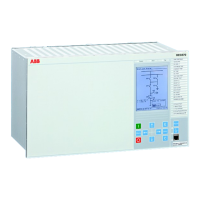Single command, 16 signals
The IEDs can receive commands either from a substation
automation system or from the local HMI. The command
function block has outputs that can be used, for example, to
control high voltage apparatuses or for other user defined
functionality.
10. Scheme communication
Scheme communication logic for distance or overcurrent
protection ZCPSCH
To achieve instantaneous fault clearance for all line faults,
scheme communication logic is provided. All types of
communication schemes for example, permissive
underreaching, permissive overreaching, blocking,
unblocking, intertrip are available.
The built-in communication module (LDCM) can be used for
scheme communication signaling when included.
Current reversal and weak-end infeed logic for distance
protection ZCRWPSCH
The current reversal function is used to prevent unwanted
operations due to current reversal when using permissive
overreach protection schemes in application with parallel lines
when the overreach from the two ends overlap on the parallel
line.
The weak-end infeed logic is used in cases where the
apparent power behind the protection can be too low to
activate the distance protection function. When activated,
received carrier signal together with local undervoltage criteria
and no reverse zone operation gives an instantaneous trip.
The received signal is also echoed back during 200 ms to
accelerate the sending end.
Three phase or phase segregated scheme logic is available.
Local acceleration logic ZCLCPLAL
To achieve fast clearing of faults on the whole line, when no
communication channel is available, local acceleration logic
(ZCLCPLAL) can be used. This logic enables fast fault
clearing during certain conditions, but naturally, it can not
fully replace a communication channel.
The logic can be controlled either by the autorecloser (zone
extension) or by the loss-of-load current (loss-of-load
acceleration).
Scheme communication logic for residual overcurrent
protection ECPSCH
To achieve fast fault clearance of earth faults on the part of
the line not covered by the instantaneous step of the residual
overcurrent protection, the directional residual overcurrent
protection can be supported with a logic that uses
communication channels.
In the directional scheme, information of the fault current
direction must be transmitted to the other line end. With
directional comparison, a short operate time of the protection
including a channel transmission time, can be achieved. This
short operate time enables rapid autoreclosing function after
the fault clearance.
The communication logic module for directional residual
current protection enables blocking as well as permissive
under/overreaching schemes. The logic can also be
supported by additional logic for weak-end infeed and current
reversal, included in Current reversal and weak-end infeed
logic for residual overcurrent protection (ECRWPSCH)
function.
Current reversal and weak-end infeed logic for residual
overcurrent protection ECRWPSCH
The Current reversal and weak-end infeed logic for residual
overcurrent protection ECRWPSCH is a supplement to
Scheme communication logic for residual overcurrent
protection ECPSCH.
To achieve fast fault clearing for all earth faults on the line, the
directional earth-fault protection function can be supported
with logic that uses communication channels.
The 670 series IEDs have for this reason available additions to
scheme communication logic.
If parallel lines are connected to common busbars at both
terminals, overreaching permissive communication schemes
can trip unselectively due to fault current reversal. This
unwanted tripping affects the healthy line when a fault is
cleared on the other line. This lack of security can result in a
total loss of interconnection between the two buses. To avoid
this type of disturbance, a fault current reversal logic
(transient blocking logic) can be used.
Permissive communication schemes for residual overcurrent
protection can basically operate only when the protection in
the remote IED can detect the fault. The detection requires a
sufficient minimum residual fault current, out from this IED.
The fault current can be too low due to an opened breaker or
high-positive and/or zero-sequence source impedance
behind this IED. To overcome these conditions, weak-end
infeed (WEI) echo logic is used.
11. Logic
Tripping logic SMPPTRC
A function block for protection tripping is provided for each
circuit breaker involved in the tripping of the fault. It provides
a settable pulse prolongation to ensure a trip pulse of
sufficient length, as well as all functionality necessary for
correct co-operation with autoreclosing functions.
The trip function block also includes a settable latch
functionality for evolving faults and breaker lock-out.
1MRK511232-BEN E
Pre-configured
Product version: 1.2
ABB 15

